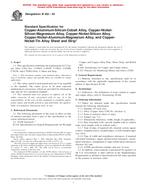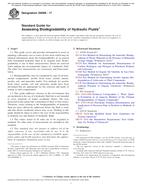1.1 These practices provide general information on the instrumental techniques available for detecting adulteration or nonuniformity of the chemical nature of the vehicle solids in purchased lots of traffic paints by means of the individual or combined use of infrared and ultraviolet spectroscopy and gas chromatography. The procedures given are applicable when traffic paint is selected and purchased on the basis of pre-qualification laboratory or road performance tests, or both, and a reference sample of the original paint so evaluated and selected is retained and compared with test samples representative of subsequent purchased and delivered lots of such paint and which are required to be the same as the original reference sample.
1.2 Although not specifically provided for in these practices, the methods given may also be applied, with appropriate modification, to evaluating the acceptability of traffic paints that have been purchased on the basis of composition specifications. In such cases, application is limited to the vehicle solids as before, as well as the availability of a suitable standard or range of standards representative of the vehicle solids that are acceptable and with which samples of subsequent delivered lots will be compared.
1.3 The techniques provided are wholly adequate for detecting gross adulteration of the vehicle solids where completely different drying oils, resins, or polymers, or combinations of these have been substituted for those originally contained in the reference sample. In cases of lesser adulteration or modification, these methods have been found adequate for detecting vehicle solids, adulterations, or modifications as low as 5 weight% of the vehicle solids.
1.4 These techniques have been developed on the basis of cooperative work with alkyd, chlorinated rubber-alkyd, and poly(vinyl toluene) type paints involving the detection of nonuniformity when such extraneous materials as rosin, fish oil, hydrocarbon resin, and chlorinated paraffin have been added. The procedures given may be, but are not necessarily completely applicable to all other types of vehicle solids or extraneous additions, or both.
1.5 The methods provided appear in the following order:
Section Method A—Infrared Spectral Analysis of Total Vehicle Solids 10 to 12 Method B—Infrared Spectral Analysis of Unsaponifiable Matter from Vehicle Solids 13 to 15 Method C—Gas Chromatographic Analysis of Oils and Oil Acids Separated from Vehicle Solids 16 to 18 Method D—Ultraviolet Spectral Analysis of Total Vehicle Solids 19 to 21
1.6 This standard does not purport to address all of the safety problems, if any, associated with its use. It is the responsibility of the user of this standard to establish appropriate safety and health practices and determine the applicability of regulatory limitations prior to use.>
Product Details
- Published:
- 10/10/1998
- Number of Pages:
- 4
- File Size:
- 1 file , 40 KB


